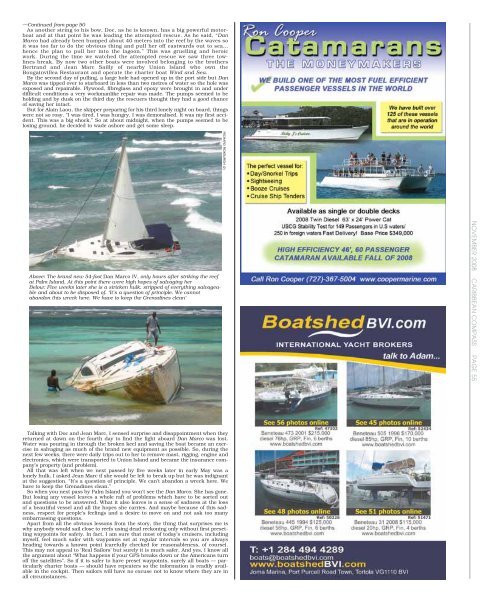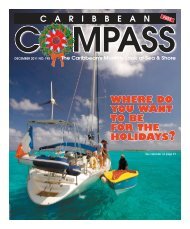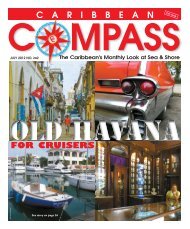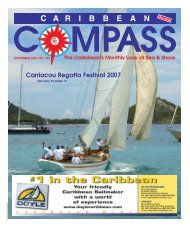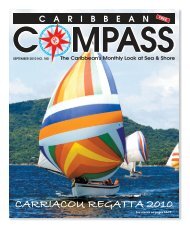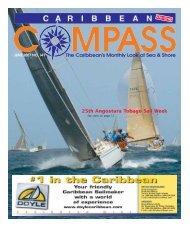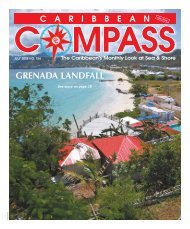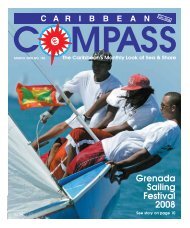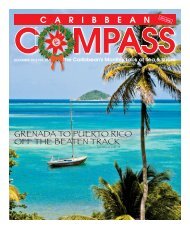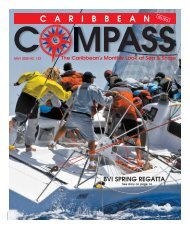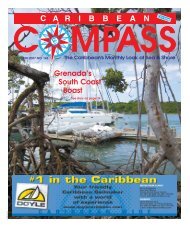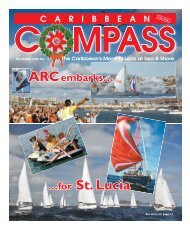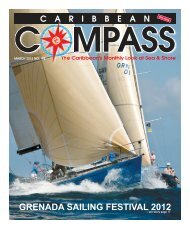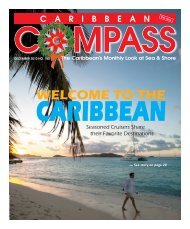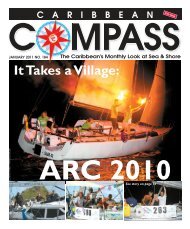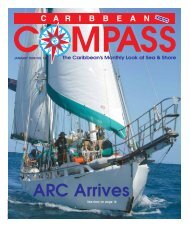A CRUISER'S VIEW OF BEQUIA - Caribbean Compass
A CRUISER'S VIEW OF BEQUIA - Caribbean Compass
A CRUISER'S VIEW OF BEQUIA - Caribbean Compass
You also want an ePaper? Increase the reach of your titles
YUMPU automatically turns print PDFs into web optimized ePapers that Google loves.
— Continued from page 50<br />
As another string to his bow, Doc, as he is known, has a big powerful motorboat<br />
and at that point he was leading the attempted rescue. As he said, “Dan<br />
Marco had already been bumped about 40 meters into the reef by the waves so<br />
it was too far to do the obvious thing and pull her off eastwards out to sea…<br />
hence the plan to pull her into the lagoon.” This was gruelling and heroic<br />
work. During the time we watched the attempted rescue we saw three towlines<br />
break. By now two other boats were involved belonging to the brothers<br />
Bertrand and Jean Marc Sailly of nearby Union Island who own the<br />
Bougainvillea Restaurant and operate the charter boat Wind and Sea.<br />
By the second day of pulling, a large hole had opened up in the port side but Dan<br />
Marco was tipped over to starboard in less than two metres of water so the hole was<br />
exposed and repairable. Plywood, fibreglass and epoxy were brought in and under<br />
difficult conditions a very workmanlike repair was made. The pumps seemed to be<br />
holding and by dusk on the third day the rescuers thought they had a good chance<br />
of saving her intact.<br />
But for Alain Laou, the skipper preparing for his third lonely night on board, things<br />
were not so rosy. “I was tired. I was hungry. I was demoralised. It was my first accident.<br />
This was a big shock.” So at about midnight, when the pumps seemed to be<br />
losing ground, he decided to wade ashore and get some sleep.<br />
Above: The brand new 54-foot Dan Marco IV, only hours after striking the reef<br />
at Palm Island. At this point there were high hopes of salvaging her<br />
Below: Five weeks later she is a stricken hulk, stripped of everything salvageable<br />
and about to be disposed of. ‘It’s a question of principle. We cannot<br />
abandon this wreck here. We have to keep the Grenadines clean’<br />
Talking with Doc and Jean Marc, I sensed surprise and disappointment when they<br />
returned at dawn on the fourth day to find the fight aboard Dan Marco was lost.<br />
Water was pouring in through the broken keel and saving the boat became an exercise<br />
in salvaging as much of the brand new equipment as possible. So, during the<br />
next few weeks, there were daily trips out to her to remove mast, rigging, engine and<br />
electronics, which were transported to Union Island and became the insurance company’s<br />
property (and problem).<br />
All that was left when we next passed by five weeks later in early May was a<br />
lonely hulk. I asked Jean Marc if she would be left to break up but he was indignant<br />
at the suggestion. “It’s a question of principle. We can’t abandon a wreck here. We<br />
have to keep the Grenadines clean.”<br />
So when you next pass by Palm Island you won’t see the Dan Marco. She has gone.<br />
But losing any vessel leaves a whole raft of problems which have to be sorted out<br />
and questions to be answered. What it also leaves is a sense of sadness at the loss<br />
of a beautiful vessel and all the hopes she carries. And maybe because of this sadness,<br />
respect for people’s feelings and a desire to move on and not ask too many<br />
embarrassing questions.<br />
Apart from all the obvious lessons from the story, the thing that surprises me is<br />
why anybody would sail close to reefs using dead reckoning only without first presetting<br />
waypoints for safety. In fact, I am sure that most of today’s cruisers, including<br />
myself, feel much safer with waypoints set at regular intervals so you are always<br />
heading towards a known point (carefully checked for reasonableness, of course).<br />
This may not appeal to ‘Real Sailors’ but surely it is much safer. And yes, I know all<br />
the argument about “What happens if your GPS breaks down or the Americans turn<br />
off the satellites”. So if it is safer to have preset waypoints, surely all boats — particularly<br />
charter boats — should have repeaters so the information is readily available<br />
in the cockpit. Then sailors will have no excuse not to know where they are in<br />
all circumstances.<br />
RICHARD ROXBURGH (2)<br />
NOVEMBER 2008 CARIBBEAN COMPASS PAGE 55


